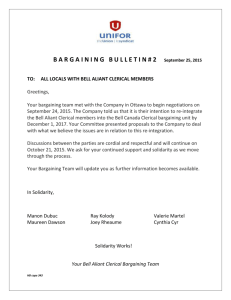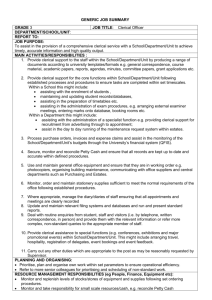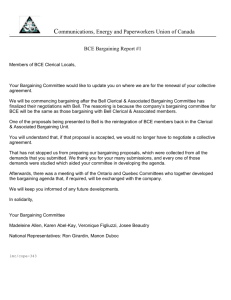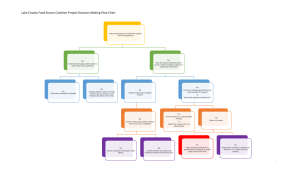PG&E – IBEW – ESC
advertisement
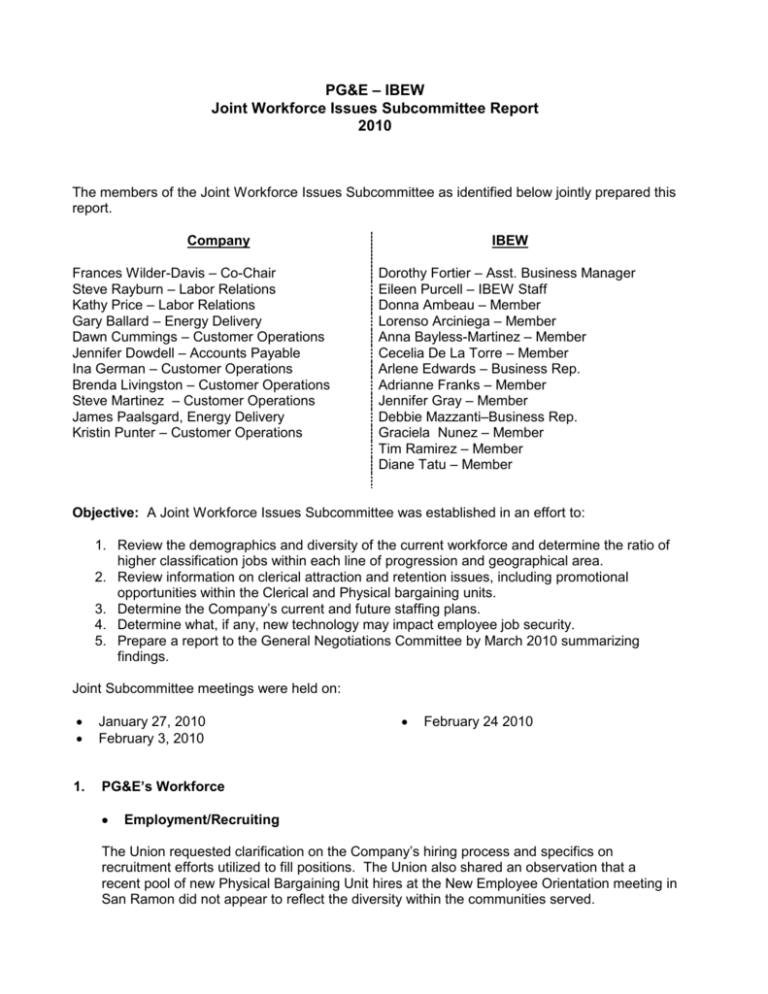
PG&E – IBEW Joint Workforce Issues Subcommittee Report 2010 The members of the Joint Workforce Issues Subcommittee as identified below jointly prepared this report. Company Frances Wilder-Davis – Co-Chair Steve Rayburn – Labor Relations Kathy Price – Labor Relations Gary Ballard – Energy Delivery Dawn Cummings – Customer Operations Jennifer Dowdell – Accounts Payable Ina German – Customer Operations Brenda Livingston – Customer Operations Steve Martinez – Customer Operations James Paalsgard, Energy Delivery Kristin Punter – Customer Operations IBEW Dorothy Fortier – Asst. Business Manager Eileen Purcell – IBEW Staff Donna Ambeau – Member Lorenso Arciniega – Member Anna Bayless-Martinez – Member Cecelia De La Torre – Member Arlene Edwards – Business Rep. Adrianne Franks – Member Jennifer Gray – Member Debbie Mazzanti–Business Rep. Graciela Nunez – Member Tim Ramirez – Member Diane Tatu – Member Objective: A Joint Workforce Issues Subcommittee was established in an effort to: 1. Review the demographics and diversity of the current workforce and determine the ratio of higher classification jobs within each line of progression and geographical area. 2. Review information on clerical attraction and retention issues, including promotional opportunities within the Clerical and Physical bargaining units. 3. Determine the Company’s current and future staffing plans. 4. Determine what, if any, new technology may impact employee job security. 5. Prepare a report to the General Negotiations Committee by March 2010 summarizing findings. Joint Subcommittee meetings were held on: January 27, 2010 February 3, 2010 1. PG&E’s Workforce February 24 2010 Employment/Recruiting The Union requested clarification on the Company’s hiring process and specifics on recruitment efforts utilized to fill positions. The Union also shared an observation that a recent pool of new Physical Bargaining Unit hires at the New Employee Orientation meeting in San Ramon did not appear to reflect the diversity within the communities served. PG&E – IBEW Joint Workforce Issues Subcommittee Report 2010 The Company provided an overview of the hiring process and invited representatives from PowerPathway™ and Talent Acquisition to share specifics about the process and related outreach effort utilized in filling Physical Bargaining Unit vacancies. Power Pathway™ was established in response to recognition that the energy industry was facing a shortfall of skilled Physical workers to enter energy careers. The program was developed in partnership with local community colleges, job corps and local governments as a workforce development program aimed at recruiting and training skilled craft Physical workers for jobs in the energy sector. In 2008, the goal was to recruit from communities served working with various constituents such as Laney College, Job Corp - SF, Tradeswomen Inc., focused on providing refresher training on test taking skills, math, soft skills, and gas and electric fundamentals. The initial training was targeted toward providing a bridge to Physical Bargaining Unit utility worker positions and resulted in a diverse pool of candidates that successfully completed the PG&E pre-employment tests. The program expanded over time to include the hiring of veterans through a program at Fresno City College; work with Cal State East Bay to establish a Certificate in Power Engineering program; training at Butte College for apprentice welders, and additional programs at Los Medanos College, City College of San Francisco, and College of San Mateo which were to prepare individuals for future apprentice positions. The program also expanded to up-skill current PG&E Fleet mechanics in support of green energy and maintenance and repair of hybrid vehicles. The Union suggested that the Company solicit Clerical employees by utilizing outreach programs at high schools to begin an early introduction to energy careers as done in previous years. The Company indicated a renewed interest in this approach and stated that consideration is being given to possibly reinstituting it. The Talent Acquisition group has worked with PowerPathway™, community based organizations, and the Company’s own diversity recruitment team which works with various associations to fill vacancies. The process for filling vacancies typically can take from two to three months and begins with a screening for basic qualifications done by an external vendor, People Scout. An example cited was in connection with pre-screening criteria for part-time Service Representative vacancies which typically include inquiries regarding customer service experience and skills. The candidate responses can qualify or disqualify someone from further consideration. The Union raised concerns about the length of the hiring process and noted that qualified candidates may not be available by the time Company is ready to actually hire them. Given the high volume of applicants, there are multiple screenings done through People Scout to identify the top pool of candidates to refer to take the PG&E pre-employment tests. That pool generally goes from several hundred to 150 referred for testing. Individuals that are not referred for testing must re-apply when vacancies are opened up on the PG&E Careers website. Those who are successful at completing the pre-employment tests are referred to the hiring department/supervisor for consideration. Part-time Service Representative jobs are filled as entry-level positions and are typically the entry-point and feeder pool into the Company. 2 PG&E – IBEW Joint Workforce Issues Subcommittee Report 2010 The Company expects to modify the hiring process in the future to bring the entire process, including the initial screening, into the Talent Connect system which is currently used for filling internal vacancies (except for bargaining-unit positions which are filled through the Centralized Job Bidding Team). Details on the Job Bidding Process are included as an attachment to this report. 2. Demographic Data The Company shared a number of reports representing workforce demographics. o Year Regular Hiring Hall o End of Year Clerical Counts: 2009 2250 93 2008 2203 135 2007 2184 237 2006 2361 136 2005 2288 68 2004 2356 60 February 2010 Total Clerical by Geographical Bid Unit (including hiring hall): Contractual Bidding Units 1 2 3 4 Contractual Bidding Areas 1-4 5-7 8-11 12 5 13-14 6 15 7 16 8 17 9 10 11 12 13 Total 18 19-20 21-23 24-26 27-28 General Company Area Count Area 2 – East Bay, Diablo Area 1 – San Francisco, Peninsula Area 7 – North Coast Area 6 - North Valley, Sierra, Sacramento Area 6 - North Valley, Sierra, Sacramento Area 6 - North Valley, Sierra, Sacramento Area 6 - North Valley, Sierra, Sacramento Area 6 - North Valley, Sierra, Sacramento Area 5 -Yosemite, Fresno Area 5 – Yosemite, Fresno Area 3 – Central Coast Area 4 – Los Padres, Kern Area 3 – Central Coast 272 162 81 22 586 25 18 18 24 438 254 509 38 2447 The information in this report reflects larger populations where there are centralized headquarters such as Contact Centers and Resource Management Centers. 3 PG&E – IBEW Joint Workforce Issues Subcommittee Report 2010 February 2010 – Sample Sum by Classification (all skill designations included) Customer Service Representative Senior Service Representative Operating Clerk Senior Operating Clerk Accounting Clerk Senior Accounting Clerk 1279 122 680 79 54 20 End of Year 2009 - Clerical by Status Active Employees - 2343 Long-Term Disability – 254 On-Leave – 82 Worker’s Compensation – 12 Clerical Employee demographic breakdown as reported by PG&E Area Area 1: 2% Area 2: 11.5% Area 3: 11.5% Area 4: 20% Area 5: 19% Area 6: 27% Area 7: 4% G.O: 4% Blank: 1% Total: 100% or o 58 EE 270 EE 271 EE 477 EE 436 EE 634 EE 94 EE 99 EE 4 EE 2343 EE Gender/Ethnicity Reporting The Company shared current workforce demographics by Area, Work City, Job Title, Male and Female (Minority, Non-Minority) and stated that utilization generally reflects the labor market. The information shared was consistent with the Affirmative Action Plans and reporting as monitored by the federal government. Overall, the Company stated that there are small pockets where there’s an underutilization of women and/or minorities. Less than 10% would fall into a category that has a goal. According to the IBEW Clerical Demographics by location and job handout, the ratio of male to female employees in the IBEW Clerical bargaining unit is 74% female and 26% male (1714 female / 605 male). 4 PG&E – IBEW Work Area Area 1 Area 2 Area 3 Area 4 Area 5 Area 6 Area 7 Joint Workforce Issues Subcommittee Report 2010 Female Minority 62% 51% 47% 46% 43% 37% 16% Total Female NonMinority 25% 25% 29% 27% 37% 30% 62% Male Minority 87% 76% 77% 73% 81% 67% 78% 11% 19% 15% 19% 10% 18% 1% Total Male NonMinority 2% 6% 8% 8% 10% 15% 21% 13% 24% 23% 27% 19% 33% 22% The Union noted that there is a concern with the balance of the workforce in Area 7 (northern coastal area). There are a total of 91 employees and the breakdown is as follows: Female: Minority 16% Non-Minority 62% Male: Minority: 1% Non-Minority: 21% 3. Future Staffing The Union believes that Resource sharing on an as needed short-term basis may in some cases be justified. However, the Union believes that the Company should fill jobs on a regular basis in accordance with the provisions of Title 18. Union also believes that additional entry level jobs should be filled in the Clerical bargaining unit. The Company reported, by line of business, that future staffing plans currently indicate no major increases or reductions. There is some dependency on the outcome from the General Rate Case funding which may dictate changes. The expectation is that all groups will manage attrition. Customer - Office Services reported that they are currently not funded to support the number of employees in the organization and the shift towards alternative payment options will continue to be a factor. The solicitation is to try and keep the organization working given 15,000 hours that are not financially supported. Thus the department has begun to seek overflow work that can be performed on a straight time basis as fill-in work for other groups needing assistance. These efforts are intended to maintain the full time employee count; however, there is uncertainty if that can be sustained, and will likely result in a need to look at an alternative staffing model in the near future. The Union inquired whether the organization is understaffed in some areas given the resource sharing from location to location. The Company shared detailed information on the work and 5 PG&E – IBEW Joint Workforce Issues Subcommittee Report 2010 resources that are being shifted, and that any understaffing situation is short-term. An example would be where there are one person offices and there’s a need for coverage behind an absent employee. Occasionally, the decision may be made to close the office during absences. Bill Print & Mail Payment Processing reported that more changes relating to bill presentment are expected and that the shift of customers to electronic methods for bill payment is expected to increase and continually diminish use of U.S. mail, impacting their workload. In addition, payment by phone will likely become more popular and impact workloads. The department indicated that they would like to explore options to increase opportunities for their employees. There are some changes that may increase or create new work given the dynamics of SmartMeter™ roll-out and implementation. Energy Delivery will continue to manage attrition and anticipates some impact as a result and through implementation of Mobile Technology which is also expected to change the way that work is performed. The department is currently going through a transition to a new organizational structure that may result in changes and that there may be other technological changes that impact work processes and workloads. Accounts Payable stated that their processes will continue to migrate towards greater automation and less paper. The need for better controls and oversight into accounting will continue to drive change in that area and the department is interested in skilling-up the workforce while looking at inevitable efficiencies that will impact work processes. The Union will continue to closely monitor the work situation in the Clerical Bargaining Unit and the Company is required to adhere to the Agreement and all other applicable notification requirements prior to reducing the workforce. 4. Survey Data The Company shared the 2009 Enterprise-wide IBEW Premier Survey results and the 2009 CCO Hear My Opinion Survey results. Premier Survey – Overall IBEW response rate - 67%, clerical response rate 26%. There were a total of 1159 Reponses on Hear My Opinion. The Survey results are for the Physical and Clerical Bargaining Unit. Therefore, the results may not accurately reflect the opinions of 26% of the Clerical Bargaining Unit. The Union continues to express concerns regarding the potentially misleading wording of the questions on the surveys. Some of the Premier Survey Areas with ratings of less than 55% Favorable are as follows: Q32 – Sr. Management (i.e. CEO/Sr. VP) gives employees a clear picture of the direction in which PG&E is headed. 33% Favorable. Q33 – My local management (i.e., Directors/Managers/Superintendents) gives employees a clear picture of the direction in which PG&E is headed. 38% Favorable. Q22 – My local management (i.e., Directors/Managers/Superintendents) promotes an atmosphere that encourages the open and free exchange of information and ideas. 52% Favorable Q38 – How satisfied are you with your opportunity to get a better job at PG&E? 45% Favorable 6 PG&E – IBEW Joint Workforce Issues Subcommittee Report 2010 Q73 – How satisfied are you with your involvement in decisions that affect your work? 50% Favorable Q70 – Policies, procedures and day-to-day work at PG&E use common sense and are simple for me to follow and do. 50% Favorable Q42 – The systems and processes within my department allow me to deliver the highest level of customer/client service. 51% Favorable Q31 – I am given a real opportunity to improve my skills at PG&E. 54% Favorable Sample Questions from Hear My Opinion Survey Q22 - How satisfied are you with your opportunity to get a better job at PG&E? Strongly Agree – 18%, Agree – 34%, Neither – 26%, Disagree – 14%, Strongly Disagree – 7% Q6 – Sufficient effort is made to get the opinions and thinking of people who work here. Strongly Agree – 25%, Agree – 51%, Neither – 16%, Disagree – 6%, Strongly Disagree – 2% Q19 – My work give me a feeling of personal accomplishment. Strongly Agree – 33%, Agree – 42%, Neither – 66%, Disagree – 7%, Strongly Disagree – 2% More detailed results for this survey can be found in the attached Hear My Opinion document. The results were fairly consistent for both surveys. The Company indicated that it will continue to work on areas for improvement which are expected to be apparent to employees. 5. Promotional Opportunities The Union stated that bargaining unit promotional opportunities have continued to diminish. Prior promotions to Foreman’s Clerk are few and far between which further exacerbate the concern, that Senior-level work has migrated to non-bargaining unit classifications. The role of the Senior position in all Lines of Progression was previously recognized by the Company as a more robust position and as the go-to person to address issues. There needs to be greater emphasis to ensure their role as Leads is maintained and utilized. The 2004-2009 year-end demographic data reports reflect the following: Classification 2004 2009 Sr. Acct Clk Sr. Oper Clk Sr. Svc Rep Total 38 112 138 288 19 78 111 208 2004 – 2009 Differential -19 -34 -27 -80 Acct Clk Oper Clk Svc Rep Total 70 532 1132 1734 52 663 1197 1912 -18 +131 + 65 +178 The Company recognizes that the number of Senior-level positions has diminished and that the work performed has migrated towards journey-level classifications. The parties have routinely 7 PG&E – IBEW Joint Workforce Issues Subcommittee Report 2010 discussed on-going work process changes in the Accounting line of progression over the years dictated by changing business rules such as SOX requirements and various other business based impacts including technological advances; and other efforts by the Company to streamline and simplify work processes. While the number of senior-level positions has been reduced by 80, the number of journey-level positions has increased by 178 for the same time period. The majority of growth was in the Operating LOP which went through the RMC consolidation resulting in the Senior Operating Clerk I-II classification. The additional positions also created opportunities for migration to that LOP. However, the number of Senior positions in the Operating LOP has significantly decreased (by 34 positions). The Company stated that it will continue to look at its workforce requirements and make adjustments to support the work which will drive staffing decisions. According to the Position Change Bidding Activity Report provided by the Company, there is a drastic decrease in opportunities to change positions within the Clerical bargaining unit and in Physical/Clerical jobs. The Company has interest in addressing job enrichment opportunities for employees and will continue to seek ways to respond to employee feedback in connection with improving job satisfaction. Following the conclusion of the joint meetings the Company was able to obtain data reflecting clerical classifications filled for the 2007-2009 time period. The specific information received is included as an attachment to this report. It reflects that during the 2007-2009 period, 1173 “changes in position” occurred in both Clerical and Physical/Clerical classifications (excludes entry-level classifications). The 1173 does not include new hires or re-hires. Changes in Clerical positions for 2007 were 426, in 2008 477 and in 2009 the total was 229. These numbers reflect a decrease in movement of nearly 50%. 6. Attraction and Retention The Subcommittee reviewed clerical termination data from 2000 – 2009 to determine if there were any attraction and retention issues within the clerical work force. That information was discussed in great detail in the Wages Subcommittee. The Union asked why the exit interview process was terminated in most areas for bargaining unit jobs since the practice is still in place for the majority of management employees. Union stated that bargaining unit employees have not participated in an exit interview in over 10 years. The Union also stated that there is a strong interest in reinstating this process for bargaining unit employees. Attachments 1. Centralized Job Bidding Process 2. 2009 CCO Hear My Opinion Survey 3. 2007-2009 Job Changes Report 8 PG&E – IBEW Joint Workforce Issues Subcommittee Report 2010 For the Company: For the IBEW: Frances Wilder-Davis Dorothy Fortier Date: 9

